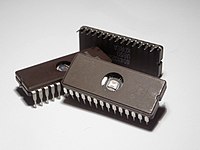
Photo from wikipedia
In this research, a novel configuration of 1D photonic crystal (PhC) is proposed for the detection of numerous elements present in human blood such as plasma, RBC, biotin, serum albumin.… Click to show full abstract
In this research, a novel configuration of 1D photonic crystal (PhC) is proposed for the detection of numerous elements present in human blood such as plasma, RBC, biotin, serum albumin. The proposed structure is envisaged with an alternate arrangement of CaF2, PtSe2 and ZnSe with a central defect layer, where the wall of the defect layer is separately coated with novel 2D materials like WS2, MoS2 and graphene to enhance the sensor performance. The well-known transfer matrix method (TMM) is employed to compute the transmission spectrum and absorption spectrum by infiltrating the defect layer with blood components. The cornerstone of this work is to observe the shift in the defect mode wavelength in the transmission spectrum. The geometrical parameters of the structure such as thickness of dielectric layers, defect layer, refractive index of dielectric layers and the number of period are judiciously optimized to realize effective sensor. The effect of variation in the defect layer thickness and angle of incidence on the transmission spectrum is thoroughly studied. Additionally, the number of layers of WS2, MoS2 and graphene are suitably optimized for design of high performance biosensor. Various sensing characteristics such as sensitivity, signal-to-noise ratio (SNR), quality factor (QF), figure of merit (FOM), resolution and detection limit (DL) are evaluated and compared for the proposed WS2, MoS2 and graphene based sensor configurations. Moreover, the simple structure, cost-effective fabrication methods and label-free detection of blood components make the proposed sensor a promising challenger for biosensing applications.
Journal Title: Optical and Quantum Electronics
Year Published: 2021
Link to full text (if available)
Share on Social Media: Sign Up to like & get
recommendations!